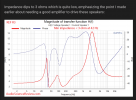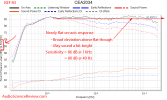I hope this post could provide some constructive insight.
The picture above is the impedance response graph of Beyerdynamic T1 1st gen.
You can see that it has about 1200Ω peaks at 80Hz and nominal impedance of 600Ω at 1kHz and above.
The table below is from my personal measurement of sine waves with a simple multimeter.
| Frequency | Voltage | Current |
| 20Hz | 1.857V | 2.30mA |
| 40Hz | 1.899V | 1.70mA |
| 80Hz | 1.912V | 1.48mA |
| 160Hz | 1.913V | 1.82mA |
| 320Hz | 1.913V | 2.30mA |
| 640Hz | 1.912V | 2.70mA |
| 1280Hz | 1.904V | 2.84mA |
Power consumption at...
80Hz: 1.912V * 1.48mA = 2.83mW
1280Hz: 1.904V * 2.84mA = 5.41mW
At 80Hz, where the impedance peak is, the power to produce (almost) same SPL of sine wave is halved.
You can read impedance from the graph but you can also calculate it from the measured voltage and current using the Ohm's Law (R=V/A).
The calculated impedance at...
80Hz: 1.912V / 1.48mA = 1292Ω
1280Hz: 1.904V / 2.84mA = 670Ω
There is about 10% margin (which is not small) because of unprofessional equipments and possible sample discrepancies but you should be able to see the logic.
I encourage all of you to do similar experiments for yourself.
Proper reasoning with a simple equipment can be a lot more "scientific" than cargo-worshipping a particle accelerator at CERN.


